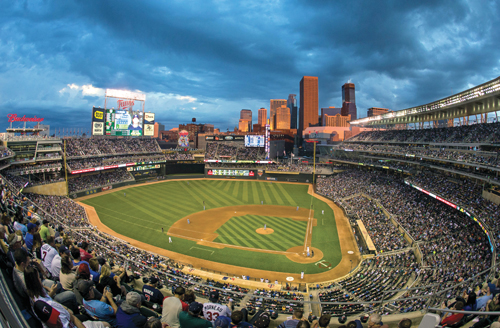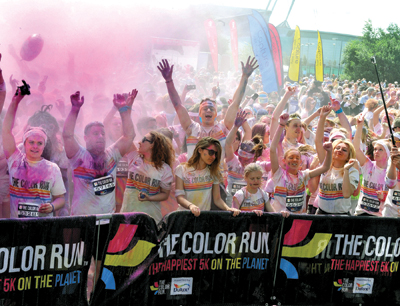To see how the MLB All-Star Game has dramatically grown and evolved, particularly in recent years, one need look no further than Minneapolis.
The last time the city played host to baseball’s midsummer classic, in 1985, the event was barely more than the game itself. A 6-1 win for the National League at the Metrodome, the game was not particularly memorable, even as it featured 14 eventual hall of famers. The Home Run Derby debuted that year, but remained years away from becoming the fan favorite and ESPN programming linchpin it is today.
 |
Target Field, site of this year’s MLB All-Star Game.
Photo by: Getty Images |
Twenty-nine years later, the All-Star Game returns to the Upper Midwest hub in an entirely transformed state. What once was a brief, 36-hour run of events is now a weeklong experience that also includes:
■ Color Run for an expected record crowd of more than 25,000 at the Minnesota State Fairgrounds;
■ Imagine Dragons concert at TCF Bank Stadium;
■ Futures Game that will include prized prospects such as Chicago Cubs phenom farmhand Kris Bryant;
■ FanFest expected to challenge attendance records posted in St. Louis and New York;
■ Multiday block party featuring several celebrity chefs;
■ Reworked, bracket-style Home Run Derby;
■ Extended run of community events that will add up to more than $8 million in charitable donations, the largest in MLB All-Star Game history (see related story).
All told, this year’s MLB All-Star Game at the 4-year-old Target Field will generate a projected economic impact of $75 million, the largest such figure for any All-Star Game outside of the New York or Los Angeles markets.
Where some other pro leagues have struggled to find secure footing for their all-star games amid sagging fan interest and competitive malaise, this year’s growth markers for baseball’s event suggest a rare vibrancy for what remains a series of exhibition contests.
“Minneapolis is one of those markets where you can really see the change,” said Marla Miller, MLB senior vice president of special events and the league’s primary point person for All-Star Game logistics. “When we were here in 1985, it was basically just a game. Now, pretty much every piece of this, even the things we’ve been doing lately, is bigger than it’s ever been.”
Urban core
The Target Field setting in downtown Minneapolis for this year’s All-Star Game, along with the nearby Minneapolis Convention Center where the FanFest will be held, provides a more urban, concentrated footprint to the events, recalling prior All-Star Games such as Phoenix in 2011, St. Louis in 2009, San Francisco in 2007 and Pittsburgh in 2006.
To that end, MLB and the host club Minnesota Twins created a marked “All-Star Walking Path” that will extend the roughly one-mile distance between the convention center and Target Field and is designed to encourage pedestrian activity between the various individual events. That green-colored path also incorporates many of the primary downtown hotels servicing All-Star Game visitors, as well as the Red Carpet Parade that will take the players to the ballpark for the All-Star Game itself.
Similarly, a newly opened line on Minneapolis’ light rail system will run between Target Field, TCF Bank Stadium and neighboring St. Paul.
“We think this is going to be the most walkable and greenest All-Star Game ever,” said Dave St. Peter, Twins president. “Walkability and mass transit are a core part of what we’re doing, and everything here is well-connected. We’re anticipating that out-of-town visitors will find great efficiencies when they get here.”
The impact of that new light rail service, the Metro Green Line, will be felt long after the All-Star Game. The Imagine Dragons concert is serving in part as a sort of dry run for the University of Minnesota as it will be the first major event at TCF Bank Stadium to incorporate the new rail service. University athletic department administrators will be closely studying the fan arrival and departure patterns in advance of the Gopher football schedule this fall.
“We’re excited about this new rail service,” said Chris Werle, University of Minnesota associate athletic director for strategic communications. “This line is going to be bringing a lot of people to our games. We’ve done a lot of studies in terms of logistics, but this concert will be a great chance to see it all in action.”
The Imagine Dragons show is the fourth free All-Star concert MLB has staged, but the first in an enclosed, private venue.
Changing perceptions
The Twins and other local entities also see the All-Star Game as a tool to help change perceptions of Minnesota and the Upper Midwest. Traditionally plagued by the harshest of winters, this past year was no exception and served to further solidify the area’s image as a frozen expanse. But the midsummer classic will be just that — a summer event staged in the most optimal time of the year in Minnesota’s climate.
“It’s hard to think of a better opportunity to showcase this market at the time when the weather is at its absolute
 |
A Color Run is among some of the events planned during All-Star Week.
Photo by: Getty Images |
best,” St. Peter said. “We think this can go a long way to remind people we’re about a lot more than snow up here.”
Much like what happened in Kansas City in 2012, this year’s All-Star Game will serve as one of the largest sports events to ever hit the Twin Cities in terms of media exposure, economic impact and overall global reach. The last event of this scale to be held in the market was the 2001 Final Four, years before the CBS-Turner Sports media alliance that transformed that tournament.
The next top-tier sports event slated for Minneapolis, Super Bowl LII in 2018, is scheduled for a new Minnesota Vikings stadium still two years from completion. So for now, MLB’s All-Star Game stands as the local standard bearer for importance and impact.
“Even beyond sports, you have to go back to the Republican National Convention there in 2008 since you’ve had anything generally of this scale,” Miller said. “But really, this kind of event is something that market will not have seen before given how everything is so much bigger now.”
The Color Run, an international series of untimed 5 kilometer races in which participants are sprayed with colored powder as they run, previously held a strong history in Minnesota, staging two successful prior events in the state.
The alignment with MLB arrived in part through mutual contacts and sponsors such as Pepsi, Nike and MTV.
The expected crowd for the July 13 race will more than double the participation of last year’s All-Star 5K race, fueled in part by the additional space available in the state fairgrounds compared to a road course. The 3-year-old Color Run, which bills itself as “The Happiest 5K On the Planet,” also will receive a significant boost in exposure through the MLB partnership as it pursues its own global expansion.
Even before this year’s All-Star Color Run was staged, MLB and Color Run executives began negotiations on a potential repeat effort during next year’s All-Star Game in Cincinnati.
“These kinds of partnerships, like the one we have with MLB, help separate us in the participatory space,” said Travis Snyder, Color Run founder and chief executive. “Finding synergistic partnerships like this are exactly the kinds of things we’re looking for.”





